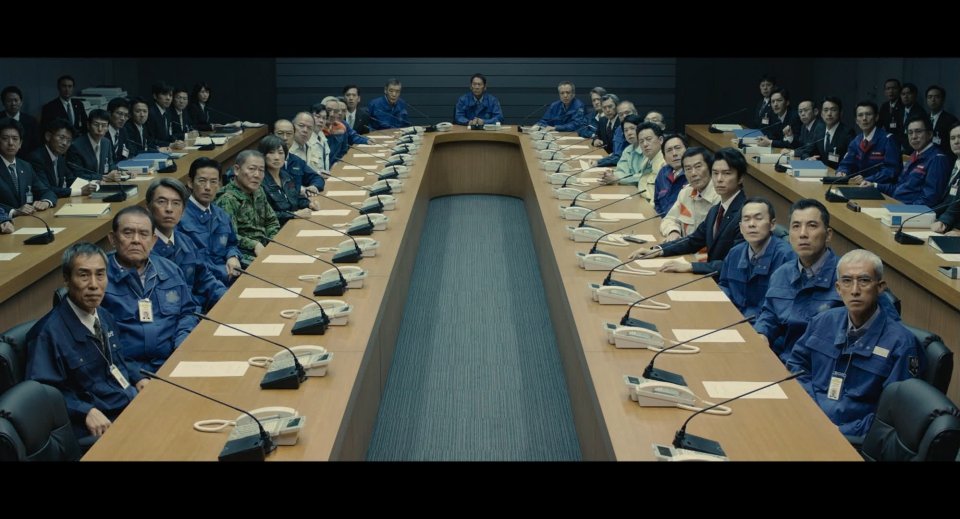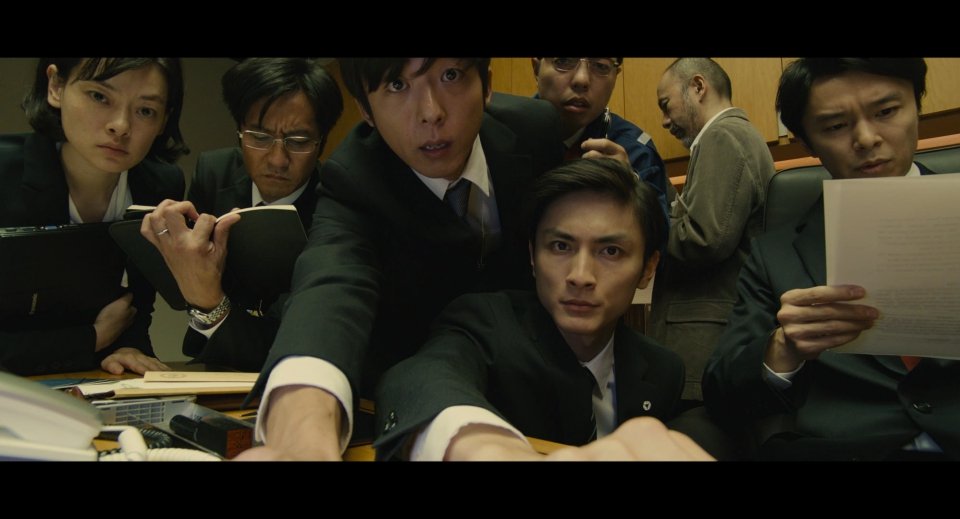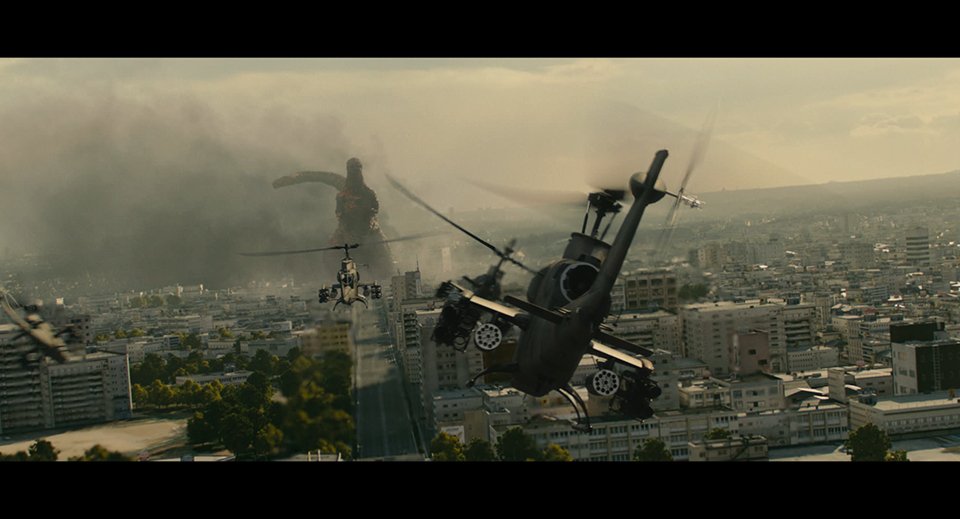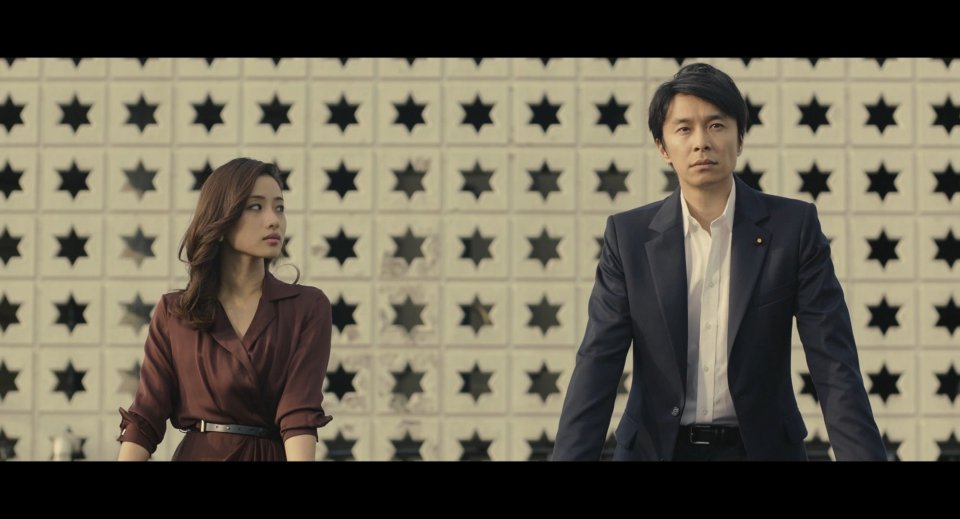Every once in a while, a movie comes along that seems to have a lot of elements that mesh incredibly well together. Of course, this is an ideal state for any film that aims to be successful. If you think about it, movies are a combination of the talent and hard work of a lot of different people with varying skills coming together to make a project bigger than any individual. Working together is a huge theme in Shin Godzilla. This and a positive message about national pride, which is surprisingly heartwarming. But, as always, I am getting ahead of myself.
Bringing Back an Icon
Movies are not made in a vacuum, so I feel it would be a bit of a disservice to not give things a little context. Until this film, the last Godzilla movie produced by the Toho Company in Japan was 2004’s Godzilla: Final Wars. While being a lot of fun for avid Godzilla fans, it was knee deep in tongue-in-cheek parody of what many of the films have become in the series. After the success of director Gareth Edwards Godzilla in 2014 (produced in the US), Toho announced that they would try their hand at bringing back Godzilla to the Land of the Rising Sun. This raised a lot of questions for fans of the Toho Godzilla films as it was unclear what kind of tone the movie will go for. Will Godzilla be fighting aliens along Minilla (don’t ask)?
As time went on, it became clearer on what we should expect, thanks to information on people working on the movie. One of the main directors for the film is Hideaki Anno, who is best known for directing the Neon Genesis Evangelion series. Along with this director, the main composer for Shin Godzilla is Shiro Sagiso, who has also worked on Evangelion. Arguably more telling is the use of stock music from late composer Akira Ifukube, who worked on the original Godzilla. With this in mind, it became quite clear that not only would this film likely be a reboot of sorts, but it would be a homage of sorts. Evangelion owes a lot to old-school kaiju (monster) movies, and there is no one more old-school than the King of Monsters. The fact that the director of such a franchise ended up working on Shin Godzilla is almost like things coming full circle in a sense.
Bureaucracy and Building Tension
The first five minutes are slow. Deliberately slow. Comically slow, even. There are a bunch of Japanese politicians in Tokyo meeting about an incident affecting the city. These men and women take their time going over policies, addressing each other in order and moving from one meeting room to the next to discuss the proper issues. During this time, the film’s score is silent and we as viewers are almost questioning what kind of film we are watching. But when things start happening, the bureaucracy is unable to keep up with rapidly changing events. Eventually, Tokyo is dealing with a crisis unlike anything it has ever seen in its existence. It is up to the young politician and all around cool guy Rando Yaguchi to put together a crack team of weirdos to battle with this strange beast.
The most interesting aspect of the film’s narrative progression is the buildup of tension. We see Godzilla quite early on, but in a form that is almost unrecognizable. As Godzilla changes, the tension builds and societal structure crumbles. This is a great way to build tension as well as have a commentary on Japanese politics. As a westerner, there are a lot of nuances lost on me, but the intent of the message was clear. What was also clear, and somewhat surprising, was none of this portrayal was mean spirited. While the government shows how ineffective it is to handle such a crisis, each of these parties were trying to protect their city and their people, but they were tethered by red tape that they were not willing to cross. The number of times that the Prime Minister says “understood” after a long meeting, tries to make a statement, and then the situation has completely changed was nothing short of comical. This example is one of the movie’s strongest points. Shin Godzilla combines tension, destruction, and humour deftly. Even when characters are doing their best to solve a problem, there are times where it blows up in their face and it is genuinely funny. There are other moments where things fail and it is absolutely soul crushing. This dichotomy is not jarring though as the situation becomes increasingly dire as the movie goes on. We as viewers are taken on the same emotional journey as the characters.
The Heroes of Japan
As I have stated earlier, I am definitely a westerner, so please bear with me while I stumble through my understanding of some of the cultural components of these characters.
One of the strongest aspects of this film is the ensemble cast that is working desperately to protect Japan. Each of the major characters contributes to the greater narrative by using their specific talents to help solve the problem they are facing. Standing out among these men and women is Yaguchi, played by Hiroki Hasegawa (Attack on Titan: Part 1, Love and Peace). He presents himself as openly being frustrated with the structure of government in a couple comical ways by not following protocol. Because of his thinking outside of the box, he is given the seemingly impossible task of putting together a team to stop this monstrous threat. He is essentially the central character as he is often front and center in many of the major scenes of this film. Yaguchi has a smoldering intensity to his character. He often seems like he is working hard to contain his frustration with any given situation, but can be confident to the point of almost cockiness when things go well. This makes Yaguchi feel like a real person with a proper range of emotions. His reaction to adversity is relatable because the viewer can tell he is overwhelmed with the threat that Godzilla possesses, but he keeps pushing himself because the only other option is destruction. He also surrounds himself with people he can depend on.
The real star of the movie is the ensemble cast that joins together to face Godzilla. While no single character has a massive arc, the main development we see in this film is Yaguchi’s crack team of scientists and weirdos as well as the Japanese government learning to adapt and work together. Each of the major characters has a different position and role withing the structure of the system. They use their power, influence, intelligence and connections to work towards a single goal. Even a seemingly useless figurehead character does his best to help in any way he can. Each of these characters has a small quirk or personality type that made them easily identifiable on screen. Everything from a woman who is unnervingly stoic to an old man referring to his fellow high-ranking government officials by using adorable terms of endearment really sell each of these people as individuals with their own lives.
Having said that, there are a lot of characters. An absolute ton. It was impossible for me to keep track of everyone on the first viewing. Again, some characters have far more screen time than others and the movie tries to assist the audience by flashing their name on screen when they first showed u. But after that, good luck if you forget who they are. Now admittedly, part of this struggle is being unfamiliar with Japanese names, but more than that, it was just because there were so damn many of them! There were a couple of characters and plotlines that I completely forgot about until they resurfaced in the film. They could easily have been dropped or adapted and the story would not have changed much.
Making a Monster
Then, of course, there is Godzilla itself. This creature was fascinating as Godzilla kept changing throughout the film, including in ways that will surprise even long-term fans of the franchise. The sense of scale is absolutely staggering at times, as Godzilla will march through skyscrapers like he was busting up an elaborate Lego model. When the monster displayed its various abilities, it was quite a shock and the level of destruction was very well done. The King of Monsters returns with new abilities we have not seen before making it more unpredictable than ever. Godzilla seemed like a force of nature that mankind could only pray to stand up against. When the creature let out its iconic screech, it felt imposing.
With this in mind, I will admit that Godzilla itself was unnaturally stiff. Despite a great combination of practical effects and CGI, it was fairly easy to tell which version was being used. But Godzilla never felt like an animal. It was much more akin to a creature from those old Super Sentai or Power Rangers TV shows. While understandable given Godzilla’s man-in-a-rubber-suit origins, it still occasionally took me out of the film.
The movie also used a lot of elaborate miniatures that were absolutely destroyed in giddy displays of carnage as Godzilla carelessly marched through buildings. This use of models really gave a weight to the destruction in ways most disaster movies can only dream of replicating. Having said that, Shin Godzilla definitely utilized a lot of CGI for the crumbling city as well and it ranges from competent to absolutely ridiculous. There is an early scene where boats are being thrown around that had me laughing laugh out loud from it’s goofiness.
The most impressive CGI were definitely the moments where explosives and artillery were used against Godzilla. These moments were stunning and really showed the desperation of the Japanese Government against a force it could not fully understand. They’re a nice surprise for newcomers and fans alike.
Visually, it’s an absolute treat. Scenes, where characters are simply talking and delivering exposition, are fun and kinetic. The clever editing, the increasingly quick pace of dialogue as the film progresses, and the composition of shots were all delivered with skill and care. Fans of the anime series Neon Genesis Evangelion will recognize camera angles and quick cuts used in that show with expert precision and execution. There is one fantastic scene where a new character is introduced and reveals new information about Godzilla. She is energetic and animated in a way no other character is up to that point in the film. The way the camera cuts quickly to show different angles of her speaking in relation to the others in the room adds a new energy to the movie that helps give the viewer and the characters some much-needed hope. This visual language is constantly used as a clever shorthand to display emotion and tone.
Orchestra of the Damned
Most modern Hollywood movies have fairly anemic movie scores that do little to actually compliment them. Shin Godzilla does not suffer from this issues at all, thankfully. The Toho Company made sure to hire a composer that would be able to capture the gravitas of the situation with the music alone: Shirō Sagisu. As the situation becomes increasingly dire, the music becomes significantly more intense. When things are almost cataclysmic, the orchestra style music gives a sense of dread that I honestly did not expect. There are even a few recognizable songs from the old Godzilla movies that are used to great effect at key moments.
The vast majority of the score for this film is absolutely fantastic and fits well with the given situation. There is one song however that was oddly distracting, but not necessarily bad in a bad way. One track used a few times throughout the movie is basically ripped right out of Evangelion. This threw me off a couple times because of my familiarity with Evangelion; it was hard to be immersed in those moments but that may be just me. The use of the track was very deliberate and if you are familiar with the aforementioned anime series, you will understand why they used it in those instances.
Putting the Shin in Shin Godzilla
Shin Godzilla is a great film with a lot of heart and optimism in an age when gritty cynicism is all the rage. There is a sense of national pride portrayed in a surprisingly positive light. While it’s message about working together may come off as too optimistic to some, it felt very fitting for this film. There are a lot of themes steeped in Japanese culture but are so universal that won’t be missed by Western audiences.
Shin Godzilla accomplishes what it sets out to do in many aspects and, while not perfect, is a fantastic reboot to the Toho Godzilla franchise. Long time fans of Godzilla will likely enjoy the hell out of this movie and new audiences will find a lot to like, even if certain references are lost on them. The term “shin” in Japanese culture has a lot of connotations. It can be translated to mean “true”, “core” “new”, or even “heart”. This title could not be more fitting for this movie.
Nedu will never forgive Matthew Broderick for Godzilla 1998. He is also a content writer for AYBOnline. His views are his own.








